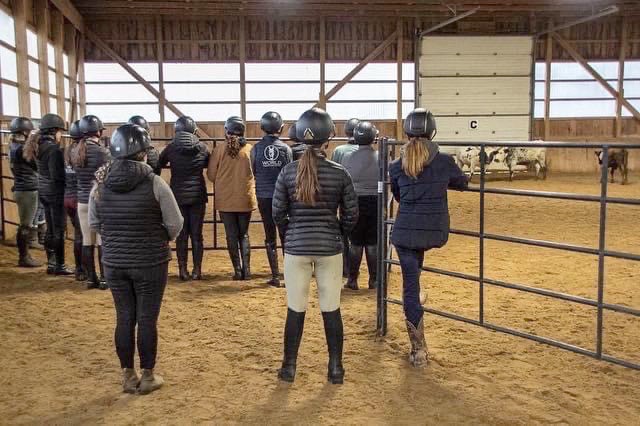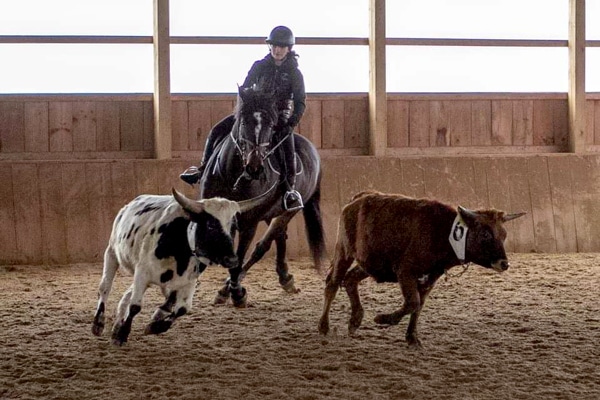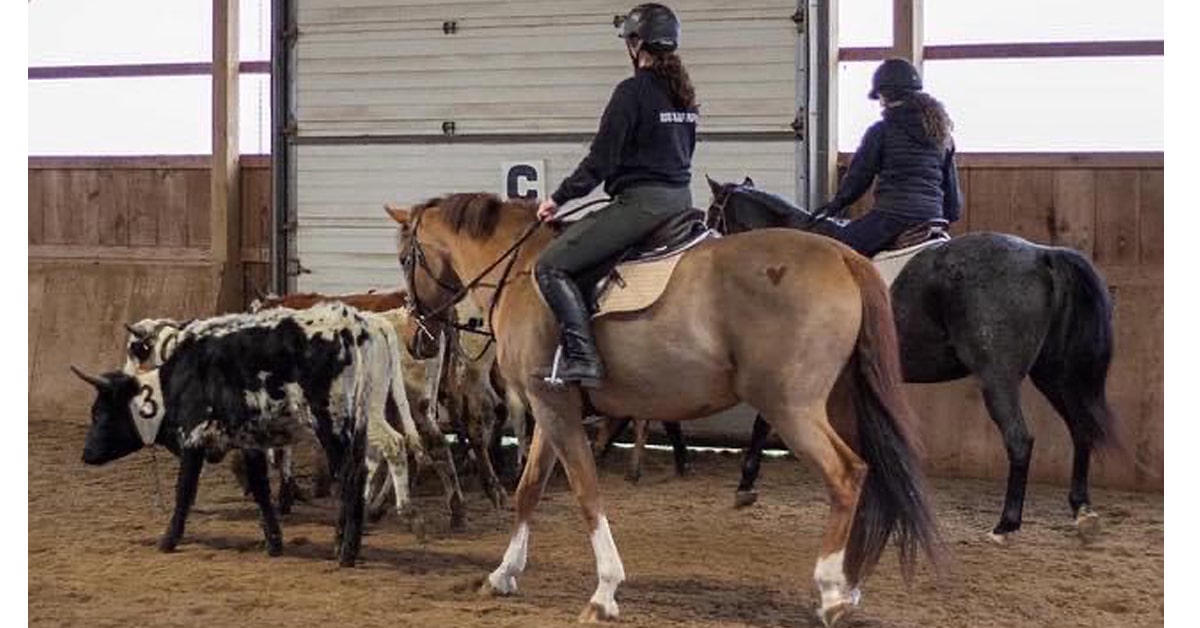Cows? Check. Horses? Check. English saddles? Check – wait, what?
You don’t often see riders cattle sorting in English tack – but lately, it’s started to become a more common sight across Ontario. Quite a few English barns have started hosting cattle sorting or team penning days, where an external farm brings in cows and leads a day clinic.
Two of the women running these clinics are Kelsey Loft and Samantha McFadyen, based out of Restoration Ranch in Ancaster, Ontario. They started the clinics when they realized that horsepeople wanted to learn how to sort, but it was difficult to trailer to another facility, and safely expose their horses to cows all in one day.
So Loft and McFadyen created their own “clinic in a box,” bringing the cows and setup to different English barns. “The response has been amazing,” Loft says. They’ve run nearly a dozen clinics so far and are booked up for all of spring until the show season. The majority of those, they say, have been at English barns.
“People want it, they find it excellent for their horses,” McFadyen says. “It’s just something different that barns aren’t exposed to all the time.”
What does a cattle sorting clinic look like?
On the day of the clinic, Loft, McFadyen, and a helper or two will arrive early to set up panels in the barn’s arena and bring in the cows (typically yearling beef cattle).
Once the day’s participants have arrived, the morning starts with the cows in the arena and people on the ground. First, people learn how to sort the cattle on foot to get a sense of how cattle move, and how to move them.

Participants learn to move cattle on foot before graduating to horseback. (photo courtesy Kelsey Loft)
Next they saddle up and work on slowly introducing their horses to cattle. Most of the horses have never seen cattle at all. “Some are great right away, others have no idea and are scared of them,” Loft says.
After the initial exposure, the first task is simply to use the horses to move the cows around as a group. “The horses realize they can push the cows, and then they usually settle down,” McFadyen says.
From there, they get the horses to actually sort one or two cows out from the bunch and over to the other side of the pen. Throughout, they frequently cycle the horses in and out to give them a mental break.
Finally, after a lunch break, it’s time for a mock sorting in the afternoon, complete with randomized teams of two, cow numbers, a time limit (sixty to ninety seconds) and scoring.
Why are English riders trying cattle sorting?
Jenny Lineker, owner of Vector Equestrian in Puslinch, recently had Restoration Ranch run a day clinic for her hunter/jumper show team. With the cattle sorting clinic, she wanted her team to experience something different with horses.
“We’re so regimented in our sport. We focus on technique, there’s a lot about how you work with your horse and how you ask them to do certain things,” Lineker says. “But doing something else where your horse becomes a little more of a partner seemed really fun for the kids.”
The clinic helped her riders with introducing their horses to something that’s foreign to them (like cows). “Samantha did any amazing job of that, to work with them to know when to push, and when to sit back and let the horse absorb what was happening,” Lineker says. “That process of getting them comfortable … they can take that away and apply that in other situations.”
Cattle sorting also gave her riders a different experience of “just feeling their horses under them, and moving with them in ways that you don’t do in our sport,” Lineker says.

Even the most timid horse usually realizes he can move the cattle around – a big confidence-builder. (photo courtesy Kelsey Loft)
“They’re not focused on the horse, but focused on the cow,” Lineker says. “It becomes about feeling what the horse is doing underneath you, more naturally.”
It can also help with working equitation classes which are exploding in popularity, which may include a cattle trial component.
Plus, Lineker says, it’s a long winter to spend training indoors in Canada. “It’s nice to break it up with something that’s just fun, and involve the horses.”
Good for the riders, good for the horses
It’s not just fun for the riders, but the horses, too. “It’s something new for them,” Lineker says. As the horses learn that they can move the cows around, they gain more confidence, as well. “Some of the horses that are little bit more lacking in confidence, you could see growing in confidence by the end,” Lineker says. “You could tell that they enjoy it.”
Some horses might also surprise you by having natural ‘cow sense’. One of Lineker’s school horses, a 20-year-old Irish Draught ex-jumper, “took to it like a natural,” she says. “He became very assertive…. he just knew how to move the cows.”
Making it fun
Loft and McFadyen both come from English backgrounds themselves. They understand it can be intimidating for English people to come out and do these clinics, so they try to keep it as welcoming an environment as possible. “It’s fun,” Loft says, “It doesn’t have to be the most ultra-competitive thing in the world.”
People have asked if they can ride in their English saddles, to which Loft and McFadyen give a hearty ‘yes.’ They want to make sure people feel comfortable to “come out and enjoy it and not feel like they’re judged in any way,” McFadyen says.
“You get people coming in the morning, and the biggest comment is ‘I might die,’” McFadyen says.
“By the end they’re saying, ‘it’s a blast!’”

